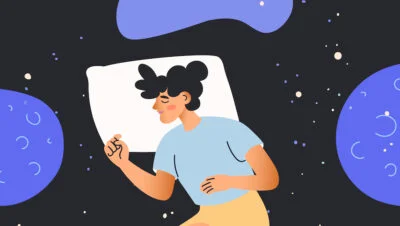In 2010, Leonardo DiCaprio and a few of his friends introduced many of us to the idea of lucid dreaming for the first time. The movie was “Inception,” and the central character, Cobb, played by Dicaprio, uses lucid dreaming (and a little bit of fictional dream-sharing technology) to infiltrate the mind of his targets. More than a decade later, lucid dreaming is still piquing our interest — somewhere to the tune of 1.7 billion views (and counting) on TikTok. If you’re one of the many trying to have lucid dreams, here’s a little more information.

What Is Lucid Dreaming?
In short, a lucid dream is a type of dream where the person is aware they are dreaming. The dreamer often has full memory of the event(s) and control over the dream narrative. Moreover, research has shown that lucid dreamers also have the ability to communicate in real-time with the awake world. But while lucid dreamers may have control over their dream, Daniel Love, aka The Lucid Guide, tells Sleepopolis “dream control itself is not a defining characteristic of lucid dreaming.”
He explains that a dream can only be characterized as lucid when (and if) the dreamer
- Knows they are dreaming
- Understands what that knowledge means (that the entire world of dreams is an illusion)
- Has mental faculties similar to that of an awake mind (such as critical, logical thinking)
Lucid dreaming is rare. Studies show that only about 50 percent of the population have ever experienced a lucid dream, approximately 20 percent do so monthly, and even fewer (about 1 percent) lucid dream several times a week.
According to Love, many people have spontaneous lucid dreams throughout their lives. He notes that it’s a common occurrence in children and teens, and “the quality of lucidity can range from a vague sense that one is dreaming (which technically isn’t a true lucid dream, but is related) all the way up to feeling as if one has “woken up” in an entirely different universe.”
Lucid dreaming can occur naturally and spontaneously, and there is evidence to suggest that lucid dreams are linked to sleep disorders — specifically narcolepsy — as well.
Lucid
Easily understood, clear, transparent.
Why Do People Lucid Dream?
Dream scholar and Lecturer on Psychology in Harvard’s Department of Psychiatry, Deirdre Leigh Barrett, Ph.D., says, “Most people who have lucid dreams find them [to be] a fascinating state of consciousness.” She tells Sleepololis that people who have them readily and regularly often use them to explore questions and lessen anxiety dreams, in addition to many other interesting applications.
The reasons people explore lucid dreaming vary. Love says that while many engage in the practice as a matter of “curiosity, self-discovery, philosophy, and spirituality, surprisingly few are drawn by escapism.” Love suspects that fun is not usually a factor, as a lot of work goes into learning how to lucid dream, and that rarely aligns with the personality types that aim to use it as a distraction. Love adds that “learning how to lucid dream requires a closer relationship with one’s mind and reality, so in many ways, it is the polar opposite of escapism.”

Is Lucid Dreaming the Same As Shifting?
In the aftermath of the COVID-19 pandemic, the concept of reality shifting emerged among post-millennials and took social media by storm. Essentially, reality shifters believe they can alter their current reality by intentionally shifting their awareness and consciousness. More specifically, shifters believe they transcend to alternate universes and realities through focused visualization.
And while reality shifting can be confused with lucid dreaming, Love says unequivocally that lucid dreaming and shifting are “not at all” the same. “Lucid dreaming is a scientifically verified state of consciousness,” says Love. “It is founded upon known and established scientific and psychological principles.” Reality shifting, on the other hand, is a very recent new-age belief system that grew in popularity on TikTok and doesn’t have scientific backing.
FAQ
What Causes Lucid Dreams
Though it may not be possible to understand exactly why lucid dreams occur, some research reveals that dreams of this type may be associated with times of stress and anxiety. Psychopathologies, such as depression and OCD, may also play a role. And although research on the subject is a bit dated, one study showed that people with a propensity for lucid dreaming might be more likely to score highly on self-assessments of creativity and to see themselves as capable of influencing events, also known as possessing an internal locus of control.
The Science Behind Lucid Dreaming
Lucid dreams were the subject of much speculation and debate until 1975, when sleep studies began to prove their existence. One of the most notable studies came from British psychologist and sleep researcher Keith Hearne, who blew the mystery of lucid dreaming wide open by connecting the dots between lucid dreaming and REM sleep.
Through a series of sleep studies, Hearne realized that, like other types of dreams, lucid dreaming tends to occur during REM sleep. And, perhaps, more importantly, while most of the body’s muscles are paralyzed during REM sleep, the eyes are not.
On the morning of April 12, 1975, Hearne made history when one of his test subjects communicated with the researcher by making a sequence of left-right eye movements as they became lucid during a dream state.
It’s been four decades since Hearne’s pioneering research, and while science has helped us decode a few more mysteries about lucid dreaming, much of what we know on the subject still stands.
Barrett tells us, “Most lucid dreams happen during rapid eye movement sleep, but some of them occur at sleep onset in Stage 1 nonREM and probably very rarely in other stages of sleep.”
Later studies showed that lucid dreaming often occurs during moments of particularly high arousal or change in brain wave activity in the outer layer of the brain. Recognition of dreaming may occur specifically in the dorsolateral prefrontal cortex, where working memory, planning, and abstract reasoning occur.
While gamma wave activity is thought to trigger lucid dreaming, Barrett says, “the two have gotten over-associated,” and the hype isn’t warranted — the prefrontal cortex is the star of the show with lucid dreaming. “What is much more distinctive to lucidity is what parts of the brain are more active than typical during REM sleep,’ she says. “These are parts of the prefrontal cortex — an area associated with reality testing, self-awareness, and abstract thought.”
Lucid Dreaming And Sleep Quality
This type of brain activity during the REM sleep stage begs the question: How does lucid dreaming affect the dreamer’s sleep quality?
According to Barrett, lucid dreaming doesn’t have a detrimental effect on sleep quality. “For the vast majority of people, lucid dreams only occupy a few minutes of sleep on some nights,” she says, adding that “while the state is atypical for dreaming sleep, it’s not taking up enough sleep time to affect the physiological benefits of sleep.”
And research shows much the same. In 2020, 149 participants were asked to keep a dream diary for the duration of a five-week lucid dream induction study. Ultimately, researchers found that lucid dreaming had no negative effect “on the feeling of being refreshed in the morning compared to nights with the recall of a non-lucid dream.” As a matter of fact, the study found that participants reported feeling more refreshed after a night with a lucid dream.
The Difference Between False Awakenings and Lucid Dreaming
False awakening and lucid dreaming are often confused, but the two are different. A false awakening occurs when the dreamer believes they have woken up but is, in fact, still asleep. Typically, the dreamer will feel as though they are awake and going about their business, getting out of bed, brushing their teeth, etc. False awakenings typically occur in the transition out of REM sleep.
With a lucid dream, the dreamer is aware they are dreaming. And while they are paralyzed in REM sleep, they may not feel that way. Moreover, as we mentioned above, lucid dreamers may be able to control the goings-on in their dream. And finally, with the understanding that they are having a dream, lucid dreamers may be able to intentionally wake up.
It may be worth noting that in 1991, Barrett studied the dreams of 200 subjects and discovered that false awakenings were more likely to occur before, during, or after a lucid dream. Barrett also found that because a false awakening is a dream and not bound by narrative limits, more than one false awakening may occur within a false awakening dream. This is called a double dream or a dream within a dream.
Lucid Dreaming As Therapy
There is some evidence to suggest that lucid dreaming may be beneficial as a type of therapy for nightmares, and new research shows that lucid dreaming can significantly decrease the symptoms of depression and anxiety.
In 2022, researchers out of Northwestern University’s Department of Psychology ran a content analysis on posts from a public lucid dreaming internet forum in an attempt to offer some more definitive answers on the subject. Ultimately, researchers found that lucid dreaming could also be used for creative inspiration, personal growth, and alleviating insomnia symptoms.
Moreover, the team identified some of the positive and negative effects of lucid dreaming.
Positive Effects of Lucid Dreaming
- Dream enhancement
- Improved creativity/gaining insight
- Improved mood upon waking
- Nightmare resolution
Negative Effects of Lucid Dreaming
- Panic or anxiety in a lucid dream state
- Poor sleep
- Reality confusion for people with certain mental health disorders
- Unwanted lucid dreams

How To Have Lucid Dream
For anyone who wants to try lucid dreaming, Daniel Love walks us through the process.
Prioritize 7-9 Hours of Sleep Each Night
Love notes that quality sleep is key to lucid dreaming. “The majority of REM (dreaming) sleep occurs in the final hours of the night, so it’s important to get a healthy amount of sleep,” he says. “Without it, learning how to lucid dream will be incredibly difficult.”
Become Familiar with Your Dreams
“Keeping a dream journal is an absolutely vital and non-optional step when learning how to lucid dream,” says Love. He adds, “In essence, lucid dreaming is learning how to “spot the difference” between waking life and dreams, and of course, that’s going to be nearly impossible if you do not become familiar with the ‘personality’ of your dream world.”
Ideally, dreamers should record every single important detail, including elements of the dream, experiences, emotions, and thoughts.
Learn to Question the Nature of Your State
Love says, “Would-be lucid dreamers must learn to regularly question their state — seriously asking themselves ‘Could this be a dream?’”
The dreamer should do this whenever waking life events resemble dreams, even if only slightly. This could mean questioning odd events, strong emotions, and coincidences. “By building this habit, eventually, it will transfer into the dream world. At some point, you’ll ask the question within a dream and finally realize you’re dreaming!”
Testing Your State
“When things occur that are dreamlike, you can (and should) also perform certain tests to establish if you are dreaming,” says Love. “The easiest ‘reality test’ is to pinch your nose and attempt to breathe through it. During waking life, you’ll obviously be unable to breathe. However, during a dream, you’ll have the uncanny experience of breathing through a pinched nose. A sure sign you are dreaming!”
Be Consistent, Experimental, and Patient
“Lucid dreaming takes time and patience, so don’t give up if you don’t have a lucid dream the first night of trying,” says Love. “Remember, this is a skill that takes roughly the same amount of time as learning a language. You’ll get more proficient the more time and energy is invested.” Love also recommends making sure you’re learning from reputable sources.
Other Tips for Lucid Dreaming
Lucid Dreaming Techniques
“There are many techniques that aim to induce lucid dreams,” says Love, “However, it is best not to assume that there is a ‘right’ or ‘perfect’ technique.” Love compares choosing a lucid dreaming technique to choosing your clothing. “In much the same way that no one piece of clothing is ‘perfect,’ no one lucid dreaming technique is perfect,” he says. “With clothing, one needs to dress according to the weather and events; lucid dreaming techniques are much like this; sleep is full of variables, and we must adapt the techniques we use to fit the circumstances.”
Mnemonic Induction Lucid Dreaming (MILD)
The MILD technique is where the dreamer memorizes the dream they woke from, then imagines becoming lucidly aware within it. They fall back to sleep, telling themselves that in their next dream, they’ll realize they are dreaming.
Reality Testing Method
The reality testing method “involves performing an action and observing if the results are consistent with results expected when awake,” says Barrett. “By practicing these tests during waking life, one may eventually decide to perform such a test while dreaming, which may fail and let the dreamer realize they are dreaming. They must be ones that vary in waking life vs. dreams for that individual.”
In “Inception,” Cobb used a spinning top — if he was awake, the top would stop rotating at some point, whereas it continued to spin infinitely when he was dreaming. If a top doesn’t do it for you, Barrett says that the following tests are common ones that work for many people:
- Looking for text to read. Reading it, looking away, and looking back to read it again. Dream text is often blurred, nonsensical, or changes on the second reading.
- Looking at a digital clock or watch. The dreamer should check to see if the numbers make sense as a time. Like reading, try looking away and looking back. The dream time will probably have changed randomly and radically at a second glance. (Analog watches do not usually change in dreams, while digital watches have a great tendency to do so. A digital watch or clock may feature strange characters or numbers that are out of order.)
- Flipping a light switch. Light levels rarely change as a result of a switch flipping in dreams.
- Looking into a mirror. In dreams, reflections from a mirror often appear to be blurred, distorted, incorrect, or frightening.
Last Word from Sleepopolis
While lucid dreaming may sound like something only Hollywood or Stephen King could cook up, it’s a very real experience for many, based on real science and psychology. Largely a mechanism of activity in the brain’s prefrontal cortex, lucid dreaming occurs when the dreamer is aware they are dreaming while still in a dream state. While some people may experience spontaneous lucid dreaming, others can learn to do it; it just takes time, practice, and patience.

























